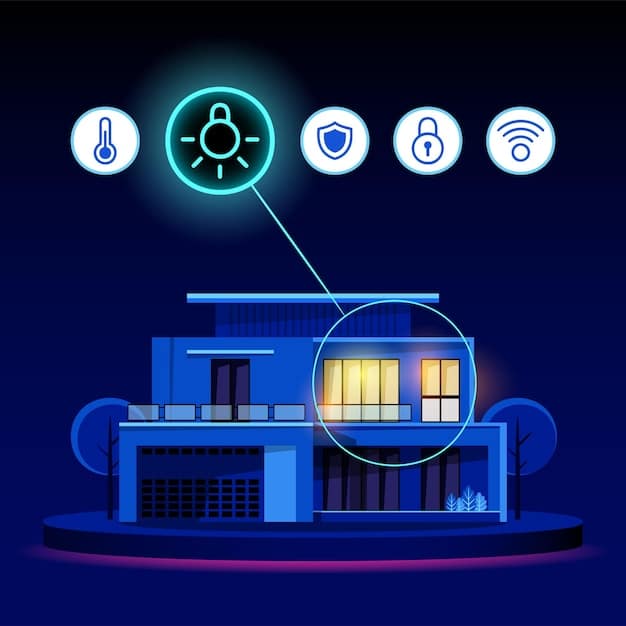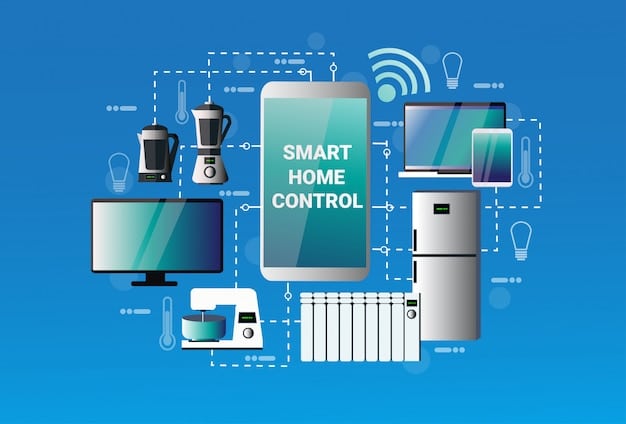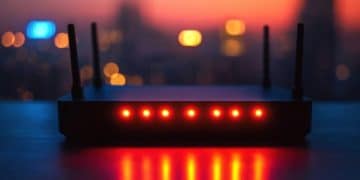IoT Security Guide: How to Protect Your Smart Home from Hackers

Securing your smart home from hackers involves understanding IoT security risks, implementing strong passwords and encryption, keeping devices updated, and monitoring network activity for suspicious behavior, ultimately safeguarding your personal data and privacy.
In today’s interconnected world, smart home devices offer convenience and automation, but they also create new vulnerabilities. Understanding and implementing robust IoT security: securing your smart home devices from hackers is crucial for protecting your privacy and preventing unauthorized access to your personal data.
Understanding IoT Security Risks
The Internet of Things (IoT) has revolutionized how we interact with our homes, but this convenience comes with inherent risks. Understanding these risks is the first step in creating a secure smart home environment. Many smart devices lack built-in security features, making them vulnerable to exploitation.
Common Vulnerabilities in Smart Home Devices
Smart home devices often have weak default passwords and outdated software, making them easy targets for hackers. Unauthorized access can lead to serious consequences, including data theft and privacy breaches.
- Weak Passwords: Many users fail to change default passwords, leaving devices exposed.
- Outdated Software: Unpatched vulnerabilities in device software can be exploited by malicious actors.
- Insecure Communication: Lack of encryption can expose sensitive data transmitted between devices and servers.
- Data Collection: Many devices collect and transmit user data, which can be intercepted or misused if not properly secured.
The Impact of IoT Security Breaches
IoT security breaches can have far-reaching consequences, from financial loss to physical security risks. Protecting your smart home is not just about convenience; it’s about safeguarding your personal information and ensuring your family’s safety.

In conclusion, recognizing the potential risks associated with IoT devices is crucial for implementing effective security measures. By understanding common vulnerabilities and the potential impact of breaches, you can take proactive steps to protect your smart home.
Implementing Strong Passwords and Network Security
One of the most fundamental steps in IoT security is implementing strong passwords and securing your home network. Weak passwords are the easiest entry point for hackers, while a poorly secured network can expose all connected devices to potential threats.
Creating Strong, Unique Passwords
Using strong, unique passwords for each of your smart home devices is essential. Avoid using easily guessable passwords or reusing the same password across multiple devices. A password manager can help you generate and store complex passwords securely.
- Password Complexity: Use a combination of uppercase and lowercase letters, numbers, and symbols.
- Password Length: Aim for at least 12 characters.
- Password Uniqueness: Never reuse passwords across multiple devices or accounts.
Securing Your Home Network
Your home network is the gateway to all your smart home devices, so it’s crucial to secure it properly. This includes enabling encryption, changing the default router password, and regularly updating your router’s firmware.
In addition, consider creating a separate guest network for visitors to prevent them from accessing your main network and your smart home devices. This can help isolate any potential threats and protect your sensitive data.
Implementing robust password practices and securing your home network are foundational steps for IoT security. These measures provide a strong defense against common hacking attempts and protect your smart home from unauthorized access.
Keeping Your Devices Updated and Patched
Regularly updating your smart home devices with the latest security patches is crucial for maintaining a secure environment. Software updates often include fixes for newly discovered vulnerabilities, and failing to install them can leave your devices exposed.
The Importance of Firmware Updates
Firmware updates are essential for addressing security flaws and improving device performance. Many smart home devices have automatic update features, which you should enable to ensure your devices are always running the latest software.
Managing Updates Across Multiple Devices
Keeping track of updates for multiple devices can be challenging, but it’s a necessary task. Create a schedule for checking for updates and make sure to install them promptly. Consider using a device management tool to streamline the update process.

In conclusion, staying on top of firmware and software updates is a critical aspect of IoT security. By prioritizing updates and implementing a systematic approach to device management, you can minimize the risk of exploitation and keep your smart home secure.
Using Encryption and VPNs for Enhanced Security
Encryption and Virtual Private Networks (VPNs) can add an extra layer of security to your smart home by protecting your data from interception and ensuring secure communication between devices and servers. Understanding how to use these tools effectively is essential for comprehensive IoT security.
Encrypting Data Transmissions
Encryption scrambles data so that it can only be read by authorized parties. Many smart home devices offer encryption options, which you should enable whenever possible. This protects your data from being intercepted by hackers.
Leveraging VPNs for Secure Connections
A VPN creates a secure, encrypted connection between your devices and the internet. This can protect your data from being intercepted on public Wi-Fi networks and prevent your ISP from tracking your online activity. Using a VPN can significantly enhance the security of your smart home.
By implementing encryption and utilizing VPNs, you can add a robust layer of protection to your smart home. These tools ensure that your data remains confidential and secure, even when transmitted over public networks.
Monitoring Network Activity and Device Behavior
Vigilant monitoring of your network activity and device behavior can help you detect and respond to potential security threats. By regularly checking your network logs and monitoring device activity, you can identify suspicious behavior and take steps to mitigate risks.
Identifying Suspicious Network Traffic
Unusual network traffic patterns can indicate a security breach. Monitor your network logs for signs of unauthorized access, such as unusual login attempts or data transfers. Security tools and apps can help automate this process.
Detecting Irregular Device Behavior
Sudden changes in device behavior can also indicate a security issue. Monitor your devices for signs of compromise, such as unexpected restarts, unusual data usage, or unauthorized access attempts. Immediate action can prevent further damage.
- Regularly Check Logs: Review network and device logs for suspicious activity.
- Use Security Tools: Employ network monitoring tools and security apps to automate threat detection.
- Set Up Alerts: Configure alerts to notify you of unusual activity.
Monitoring network activity and device behavior is an essential component of IoT security. By staying vigilant and proactive, you can identify and address potential threats before they cause significant damage.
Securing Specific Smart Home Devices: Best Practices
Different smart home devices require specific security measures tailored to their unique functions and vulnerabilities. Understanding how to secure each type of device is crucial for creating a comprehensive IoT security strategy.
Smart TVs and Streaming Devices
Smart TVs and streaming devices can be vulnerable to hacking if not properly secured. Change the default password, disable unnecessary features, and regularly update the firmware to protect your privacy. Consider covering the camera when not in use.
Smart Speakers and Voice Assistants
Smart speakers and voice assistants can collect and store sensitive data. Review your privacy settings, disable voice recording, and secure your Wi-Fi network to protect your personal information. Be mindful of what you say within earshot of the device.
Smart Locks and Security Cameras
Smart locks and security cameras control access to your home, making them prime targets for hackers. Use strong passwords, enable two-factor authentication, and regularly update the firmware to maintain the security of your home. Ensure that the cameras are securely mounted and cannot be easily disabled.
In conclusion, securing specific smart home devices requires a tailored approach that addresses their unique vulnerabilities. By implementing best practices for each type of device, you can create a more secure and resilient smart home environment.
| Key Point | Brief Description |
|---|---|
| 🔑 Strong Passwords | Use unique, complex passwords for each device. |
| 🛡️ Network Security | Secure your Wi-Fi with encryption (WPA3) and a strong password. |
| 🔄 Regular Updates | Keep all devices updated with the latest firmware. |
| 💡 Security Monitoring | Monitor your network and devices for suspicious activity. |
Frequently Asked Questions (FAQ)
▼
The biggest risks include weak passwords, outdated software, insecure communication, and data collection vulnerabilities. These can lead to unauthorized access, data theft, and privacy breaches.
▼
Use a combination of uppercase and lowercase letters, numbers, and symbols. Aim for at least 12 characters and never reuse passwords across multiple devices.
▼
Updates often include security patches that fix newly discovered vulnerabilities. Failing to install these updates can leave your devices exposed to exploitation by hackers.
▼
A VPN creates a secure, encrypted connection for your devices, protecting your data from interception. It enhances security, especially when using public Wi-Fi, and prevents your ISP from tracking your activity.
▼
Regularly check your network logs for unusual traffic patterns or login attempts. Use network monitoring tools and security apps to automate threat detection and set up alerts for suspicious activity.
Conclusion
Securing your smart home requires a proactive and comprehensive approach. By understanding the risks, implementing strong security measures, and staying vigilant, you can protect your personal data and enjoy the convenience of smart home technology without compromising your security. Regular updates, strong passwords, and diligent monitoring are your best defenses against cyber threats.





